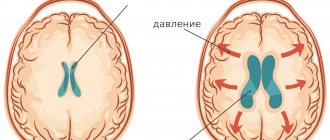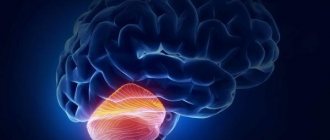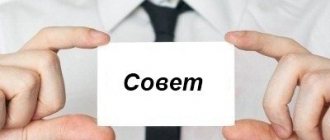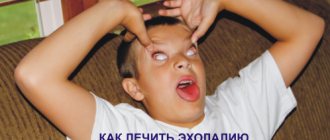In early childhood, neuropsychiatric disorders such as tics are quite common.
The scientific name is tic hyperkinesis. Parents immediately notice changes in the baby’s behavior. Uncontrolled movements of certain parts of the body or certain muscles in a child cannot but become a cause for concern and questions arise:
- Where did the disease come from?
- Could it have been prevented?
- What to do?
- How to treat?
This list can go on for a long time. One thing is clear - there is certainly cause for concern. And the first thing you need to do is find out as much information as possible about this neurological disorder.
So what are nervous tics in children and what is their danger?
General concept of ticks
This is the most popular pathology of the children's nervous system at an early age. It is simply impossible not to visually notice the manifestation of a tic, although some parents manage to go for weeks or even months without seeing any oddities in their child’s behavior.
Tics are involuntary, stereotypically repetitive, sudden or jerky movements that are the result of spontaneous contraction of individual muscles or groups of muscles.
At the initial stage of development of the disorder, attacks occur quite rarely, and repetitive movements do not cause much concern or problems. The child can even restrain or control them. However, attempts to control the tic cause him:
- internal discomfort;
- feeling of anxiety;
- mental stress.
When control over oneself weakens, tic manifestations occur, and the baby immediately receives obvious relief.
Nervous tics in children are usually detected between the ages of two and fifteen years. In the period of 6–8 years, tic hyperkinesis most often develops, while at 14–15, in approximately half of the cases it disappears spontaneously.
Fun fact: Boys are five times more likely to have the disorder than girls. From a scientific point of view, this is explained by the more stable psyche of female representatives.
Increased fatigue. The child gets tired quickly
In most cases, increased fatigue and exhaustion of the child’s nervous system has very specific causes and is quite easy to correct or treat.
It is very important to understand and find the reasons why fatigue occurs. Treatment must precisely target the cause of the problem. Unfortunately, we often see the opposite examples. For example, a child gets tired due to a chronic infection, and he is taken to a psychologist and “behavior is corrected,” or, for example, the cause of fatigue is related to hormonal levels, and he is sent to a psychiatrist and prescribed medications that are unnecessary in this case. The opposite situation is possible: the child does not have any special health problems, but only psychological problems that lead to fatigue. It is necessary to clearly understand the reason for what is happening, and only then the treatment will bring the desired result.
A child's abrupt switching from active and dynamic games to complete loss of strength, in which the child can fall asleep in one minute, is the norm for children from two to five years old.
At this age it will be absolutely normal fatigue followed by a transition to activity.
Increased fatigue should alert you if:
- The child is so tired that he cannot concentrate, lags behind his peers in learning and mastering new skills;
- The child cannot sleep or wakes up at night, feels drowsy during the day;
- In the morning the child wakes up tired, has difficulty turning on, refuses breakfast;
- The child often suffers from colds;
- You notice a prolonged (more than 2 weeks) general lethargy in the child, dark circles under the eyes and pallor, a decline in mood;
- The child is in a negative mood most of the time, gets offended and cries for no objective reason;
- Drowsiness, apathy and indifference to previously favorite activities appear;
- The child complains of headache or dizziness;
- The child loses motor dexterity, shows aggression, and often changes positions when reading or doing homework;
- The child complains of fatigue and/or pain in the legs.
Increased fatigue is mainly due to the fact that the child's nervous system cannot maintain arousal long enough to support everyday tasks, including learning, mastering skills, speech, and so on.
A tired child finds it difficult to maintain attention on one thing, it begins to dissipate, as a result of which the child resists learning, which turns out to be too difficult for him. The situation develops into conflicts, and the reason for this is increased fatigue.
- Exhaustion of the child’s nervous system due to prolonged stress,
i.e. “getting stuck” of the body in a state of preparation for responding to danger. The stress response is designed by nature to be short-term; it comes to quick realization and a way out of stress. But if suddenly the stress readiness in the child’s body becomes long-term, the nervous system is gradually depleted. Thus, brain exhaustion occurs and, as a result, rapid fatigue. - Sleep disturbance .
Normal healthy sleep consists of four stages, of which the deepest and most important are the 3rd and 4th. With a deficiency of deep stages of sleep, nervous exhaustion occurs quite quickly. Frequent variants of sleep deprivation in children: the child has a normal sleep duration, but sleeps superficially, the child sleeps with awakenings, the child has shortened sleep (falls asleep for a long time or wakes up too early). Some sleep problems can be clarified by performing overnight EEG monitoring. - The presence of increased intracranial pressure
, when the brain is pressured by an excessive amount of cerebrospinal fluid and cannot remain in a state of excitement for a long time. - Chronic diseases,
and very often these are metabolic disorders, infections (adenoids, chronic tonsillitis), decreased thyroid function or other endocrine imbalance. Chronic infections can be associated with the herpes virus, streptococci, which very often cause such chronic fatigue. In this case, we will suggest that you put the child’s immunity in order, treat infections, and then the health of the child’s nervous system will be restored.
Types of nervous tics in children
Each child has his own individuality, and therefore nervous tics that arise for one reason or another are different.
Tic manifestations generally have two types:
- Motor (motor). They are detected by spasms of individual muscles, their groups or movement of limbs and other parts of the body.
- Voice (vocal). They can be recognized in the form of frequently repeated individual sounds, syllables, exclamations, words and even phrases.
Both groups are divided into simple and complex tics. Everything is clear here. A simple form - one short movement or sound, a complex one - several muscle groups are involved, if there are vocal disorders, progress is also observed in them.
Why your hands shake: reasons
Tremor refers to an involuntary oscillatory movement (shaking) caused by muscle contraction. Trembling can be short-term and constant, and the amplitude of movements can also differ - from barely noticeable to very frequent and sweeping.
Tremor can affect different parts of the body: when seeking medical help, some patients complain of trembling in the limbs, others have a shaking head, and in others the whole body. Trembling can be observed on one side (tremor of one hand) or be symmetrical. In this article we will take a closer look at such a condition as tremor in the hands.
Experts distinguish between physiological and pathological tremor.
- In the first case, we are talking about a functional disorder (primary tremor), not associated with any disease - as a rule, such a disorder is temporary and does not require special treatment.
- Pathological (secondary) tremor is a symptom, consequence and/or complication of a certain disease.
Main manifestations
Localization of tic movements most often occurs in the facial or neck muscles. Over time, they can spread from top to bottom. The most common examples of simple childhood motor tics are:
- frowning;
- blinking;
- squinting;
- moving the wings of the nose;
- drawing in air through the nose;
- twitching of the corner of the mouth;
- turning or tilting the head;
- shrug;
- flinching;
- twitching of limbs;
- flexion or extension of fingers;
- snapping fingers.
Vocal tics are manifested by coughing, throat sounds, sniffling, spoken syllables or exclamations. This is a meaningless sound that interferes with speech and gives the impression of stuttering or stuttering. If no measures are taken to eliminate them, the situation will only get worse. Tic movements also progress and reach a new level in the form of:
- grimace;
- head tossing;
- touching various parts of the body with hands;
- contractions of the abdominal muscles or diaphragm;
- squats;
- bouncing.
All of the above nervous tics in children are not all manifestations of the disease. They can be individual and atypical. It all depends on the child’s level of development, his character and temperament, sensitivity to environmental stimuli and a number of other reasons.
Classification of the disease
The main classification divides hyperkinesis into two large groups depending on the nature of changes in muscle tone.
- Hypotonic conditions, characterized by rapid movements: tics, chorea, tremors of the limbs, involuntary muscle contractions.
- Dystonic (slow) conditions, which manifest themselves in spasmodic closing of the eyelids, torticollis, unconscious flexion and extension of the fingers and toes.
Due to the origin, the pathology can also be primary, which is caused by congenital abnormalities in the development of the central nervous system or heredity, and secondary, when hyperkinesis was a consequence of an injury or disease.
Features of the course of the disease
Initially, the child exhibits motor tics, and if the situation worsens, then vocal tics join them. However, there are cases when hyperkinesis begins with sound tics, which significantly complicates diagnosis and delays treatment.
In severe cases, several types of spontaneous movements are observed simultaneously. Sometimes they are accompanied by vocal tics.
Nervous tics in children have their own characteristic features, which make it possible to distinguish them from other pathologies of motor functions. They can be divided into several points:
- Self-control. It should be noted that it works only in the early stages of the disease. This means that the child can control his seizures, but over time it becomes more and more difficult to do so.
- Increased symptoms due to stressful situations. The same tendency is observed at the end of the day due to overwork of the nervous system. The autumn-winter period is the peak of the disease.
- The child's consciousness is not affected in any way. This fact allows us to exclude the development of epilepsy.
- Hyperkinesis does not occur during sleep. This feature is relevant in the presence of vocal tics and confirms the absence of pathologies of the upper respiratory tract.
- A nervous eye tic in a child can at first be mistaken for developing conjunctivitis, but soon everything becomes clear.
The following pattern has been noticed: the earlier the disease appears in a child, the more severe it will be. If appropriate measures are not taken, hyperkinesis develops into a chronic form. In this case, treatment is complicated by the fact that several muscle groups may gradually be involved. Pathological movements move from the head to the lower organs and become more complex, vocal tics are added. Doctors assess them as generalized.
Tic manifestations that arise after the age of ten are almost always classified as transient. This means that they disappear spontaneously and unnoticed, just as they appeared. They are also called transient. They do not require special participation from the medical side.
Dream-speaking (somnilongvia)
Sleep-speaking (somnilongvia) is the pronunciation of various sounds, screams, and phrases during sleep. This may occur repeatedly throughout the night, but rarely results in awakening. Speech during sleep-talking is usually short and fragmentary, but in some cases it is possible to pronounce incoherent phrases with emotional overtones. Dream talking can be spontaneous or induced by other people addressing the child. This phenomenon is benign and generally does not require special therapy.
Causes
Despite countless years of research into nervous tics in children, doctors have not been able to come to a common point of view regarding the provoking factors. But among many theories, it was found that the most likely are the consequences of traumatic influences. These include:
- Fright.
- Fear.
- Divorce of parents or forced separation from one of them.
- Change of environment.
- First of September. The first days of school are extremely stressful for a child.
- The birth of a second child in the family.
Heredity also plays an important role in the occurrence of tics. Children whose parents experienced hyperkinesis in childhood are much more likely to develop it too.
An unstable situation in the family or immediate environment that a child encounters in kindergarten, school, or in the yard is, of course, the main provoking factor. Children's relationships, communication with peers and adults, can be of a very diverse nature. They often contain conflict situations, and they serve as the starting point of nervous disorders.
Organic brain damage can also cause nervous tics in children. Sometimes they are a consequence of the following events:
- severe maternal pregnancy and difficult childbirth;
- traumatic brain injury;
- a previous neuroinfectious disease.
Separately, it should be mentioned that the reasons for the development of tics may be hidden in a lack of any vitamins, minerals or trace elements.
Since the child’s body is just being formed and is very unstable to external influences, hypovitaminosis can cause disturbances or malfunctions of the nervous system. It has been noticed that the disease progresses in waves. If the child is in a calm, balanced mental state, then tic movements may decrease to minimal manifestations or not be observed at all. At the same time, any stressful situation, fear or anxiety, serves as an impetus for exacerbation of the condition and intensification of tics.
Child rolling his eyes: psychological or medical problem?
In most cases, the problem with eye rolling in a child has very specific causes (most often they are associated with disruption of the brain, but there may also be psychological reasons).
Symptoms and causes.
Rolling the eyes upward is normal for a newborn baby up to one month of age. Especially before bed, during the borderline state between sleep and wakefulness. But if a child rolls his eyes downward, you should pay attention to this and contact a pediatric neurologist. This phenomenon can occur for many reasons. The most common cause of eye rolling in newborns is increased intracranial pressure. The cause may also be nervous tics and Tourette's syndrome, obsessive-compulsive disorder, i.e. relieving the child's increased nervous tension through some repetitive action.
One of the common tics is associated with rolling the eyes, twitching the eyes, or briefly looking in the same specific direction. Epilepsy can also be manifested by eye rolling. Petite epileptic seizures - absence seizures - are often accompanied by rolling of the eyes and a short-term “freezing”, stopping all higher mental functions of the child. Those. the child stops, falls silent, freezes, rolls his eyes, and after a while he “turns on” and continues to act as if nothing had happened. This is a manifestation of epileptic absence seizures. A minor epileptic seizure can develop into a major one. In this case, the child first rolls his eyes, then twitches one or more muscles, and after this a full-blown convulsive attack occurs - this is a more severe manifestation of epilepsy.
Other options are also possible.
For example, a child may have pain in the eyes, eyeballs with various diseases associated with the nasopharynx and ears (adenoids, inflammation of the sinuses, tonsils, or inflammation of the ears), when pain occurs in the area of the facial skull and soft tissues of the face, pharynx. Who do you turn to when your child rolls their eyes?
In case of such symptoms, it is necessary to show the child to a pediatric neurologist and ophthalmologist, as well as an otolaryngologist if there are any specific problems. But first, we still recommend consulting a pediatric neurologist.
Diagnostic procedures
Before starting any treatment, you need to have your child examined by a specialist. After the initial examination, the neurologist refers the patient to undergo electroencephalography. It makes it possible to identify the following indicators:
- local cerebral disorders;
- foci of pathological activity;
- analysis of the state of brain activity.
Repeated studies allow you to monitor the effectiveness of the therapy. A biochemical blood test is mandatory. If the doctor deems it necessary, the child may be sent for an MRI.
Identifying nervous tics in young children, establishing their causes and prescribing adequate treatment is the task of a neurologist. But the direct responsibility of parents is to ensure a comfortable stay for the child at home, in an educational institution or on the street. It is necessary to find out the factors that pose a threat to the baby’s psyche and eliminate them in any way.
Treatment
Very often, children who are diagnosed with tic hyperkinesis do not need special therapy. It is absolutely meaningless, and only correction of the patient’s lifestyle helps. However, if the tics become generalized, then treatment cannot be avoided. But which method the doctor chooses depends on the severity of the disease, age and physical characteristics of the child.
An integrated approach to treating tics in children is possible. It includes:
- Activities aimed at properly organizing the child’s daily routine. Protecting him from stress, anxiety and other troubles.
- Drug-free therapy. This complex includes a visit to a psychotherapist, physiotherapeutic procedures, and reflexology.
- Treatment with medications.
At the initial stages of the development of tics in young children, only routine measures are sufficient for visible positive dynamics. Rationally organized time for activities and rest, timely going to bed, proper nutrition, and exercise are the key to a positive outcome from a nervous disorder.
Family psychotherapy is of no small importance. If the situation in the family has given impetus to the development of tics, then you need to try to correct it. Under no circumstances should the child witness quarrels or scandals. It is necessary to create a calm, trusting environment so that the child feels loved and protected. You should not pull back or remind him of his nervous disorder, as this will only aggravate the situation.
Good results in the prevention and treatment of tics are provided by educational games using fine motor skills, art therapy, and relaxation. The most commonly used physiotherapeutic methods to combat this disorder are:
- biofeedback method;
- audiovisual stimulation method;
- acupuncture;
- laser therapy;
- ozokerite applications;
- massage of the cervical-collar area;
- electrosleep.
In cases where drug treatment cannot be avoided, sedatives are first prescribed.
They have a general calming effect, remove nervousness and irritability. If the expected effect is not observed, the doctor prescribes tranquilizers. Their scope of action is the relief of emotional stress, anxiety and fears. With progressive tic hyperkinesis, which is not amenable to gentle treatment, more severe drugs are used. These include antipsychotics and antidepressants. Unfortunately, these medications have a lot of side effects and are used only as a last resort, only as prescribed by a doctor and strictly following the dosage. The main indicator for use is the safety of the child, taking into account the special sensitivity of the not yet formed organism, including the nervous system.
Treatment of tics in children is usually carried out on an outpatient basis, since hospitalization can be an additional source of anxiety. For the same reason, drug therapy is avoided by injection.
Diagnosis of the disease
Recognition and treatment of hyperkinetic behavior disorder in children requires a comprehensive approach. The diagnosis is made based on a number of studies, which include:
- determination of neurological and psychological status using various techniques;
- assessment of the child’s medical history, environment, environment and living conditions;
- consultation with an ophthalmologist, psychiatrist, geneticist;
- electroneurophysiological examination;
- magnetic resonance or computed tomography of the brain;
- complex of laboratory tests.
The main task at the diagnostic stage is not only to identify the characteristic signs of hyperkinesis, but also to exclude other pathologies that may give a similar clinical picture, for example, epilepsy, Schilder-Addison syndrome.
Possible consequences
Nervous tics in children of different ages, regardless of the cause, are signals that not everything is all right with the child, his mental state is at the limit of his capabilities, and he needs immediate help. If the irritant is removed in time, the tic manifestations go away spontaneously.
What happens if you leave everything as is? There are several possible scenarios here:
- Epilepsy. Tics may be symptoms of the early stages of this severe neurological disease.
- Severe neuroses, psycho-emotional disorders. Untreated hyperkinesis progresses in the child’s body, causing new manifestations of the tic condition. Lack of qualified help leads to the development of depression and other critical conditions.
- Tourette's syndrome. Although this mental disorder is not a consequence of parental inactivity, its clinical picture necessarily includes both motor and vocal tics.
Even if hyperkinesis disappears on its own after a week without any consequences, it is necessary to go to the doctor and undergo diagnostic procedures. This is a guarantee of the child’s health, and is done with the aim of eliminating the above diseases.
Chin tremor in a newborn: the child's chin trembles
In most cases, these symptoms disappear completely with timely diagnosis and treatment, especially if treatment is started in the first six months of the child’s life.
When a newborn baby's chin trembles, this almost always indicates increased stimulation of the nervous system. If the chin trembles frequently or constantly, it means that excitation in the child’s central nervous system significantly dominates inhibition. And this, in turn, may indicate a history of brain damage: intrauterine infection, intrauterine and/or birth hypoxia, birth trauma, increased intracranial pressure, etc. In this case, the child’s chin shakes while crying or spontaneously. Other neurological symptoms may also appear. An increase in muscle tone is often observed; the baby does not form the correct reflexes inherent in newborns: proboscis reflex, palmar-mental, palmo-oral, support reflexes. There may also be other neurological signs indicating that the nervous system has been damaged in some way. In more serious cases, early development may be impaired.
Where to start and who to contact? If a child often experiences chin trembling, first of all, he should get an in-person consultation with a pediatric neurologist. The doctor will examine the baby and, if necessary, prescribe an ultrasound of the brain and ultrasound of the cerebral vessels to look at the situation with intracranial pressure and cerebral circulation. If epilepsy is suspected, encephalography (EEG) is advisable. As a rule, the most relevant age for research and determination of the causes of this problem is up to six months, since most of the consequences of intrauterine and birth damage to the nervous system are well restored during the first 6-12 months of life (the so-called “therapeutic window”). It is at this moment that every effort should be made to ensure that the damaged functions are fully restored and continue their development as normal.
Adaptation in society
Children, as we know, are cruel by nature, so it will be very problematic for a child with obvious manifestations of hyperkinesis to adapt to a new team. But it’s not his fault that the nervous tic happened to him. When communicating with adults, it is very important for him to feel a tolerant attitude. And if at home they constantly focus attention on this topic and reprimand the child, believing that he is doing this on purpose, the situation only gets worse.
Parents should be completely on the side of the child, and he should feel this not only in words. This is what it should look like:
- all conversations about nervous disorders, including tics, should be prohibited, especially in the presence of a baby.
- do not focus on the problem, behave freely and naturally.
- conduct an explanatory conversation with teachers or educators of the team that the child attends, and call on them for assistance.
- choose a suitable leisure activity for your child. Single active sports, such as skiing or swimming, are encouraged.
- provide nutritious and varied nutrition.
During adolescence, a teenager’s body is unpredictable, and also undergoes hormonal changes. If at this stage nervous tics are also detected, then this can generally turn into a personal tragedy. First of all, self-esteem suffers; the child withdraws into himself, does not want to communicate with anyone, and is fixated only on his illness.
The parents’ task is to consider the threat in time and take all measures to eliminate it. Even if the tics do not go away on their own, there is every chance that properly selected therapy or medication will help get rid of them. In any case, you can and should strive to live a full life.
Prevention Tips
To prevent a child’s nervous tics from developing into more serious mental disorders over time, all possible measures must be taken to prevent them. You don't need anything supernatural to do this. It will be enough not to forget that the baby sees the behavior of the parents and people around him, draws his own conclusions and evaluates the events taking place due to his level of development.
The psyche of a child at an early age is unstable and vulnerable, so any clarification of the relationship between parents in a raised voice is a stressful situation that can lead to tic manifestations. It is in the family that the child should feel support and understanding. This is his fortress, in which, if necessary, he can hide from all his fears. If there is no such relationship, then the risk of developing tics is quite high.
Children living in a calm, friendly environment are very rarely susceptible to nervous tics. To avoid having to treat the consequences of mental imbalance in a child, it is enough to create comfortable conditions for him. They are as follows:
- avoidance of anxiety and stressful situations;
- healthy, full sleep;
- high-quality and healthy food, a ban on fast food and overly sweet and fried foods;
- compliance with the daily routine, proper organization of rest;
- dosed computer use and TV viewing;
- maximum exposure to fresh air;
- classes in sports sections that match the interests and temperament of the child;
- inadmissibility of overwork.
In rare cases, raising the younger generation does not involve punishment. They are certainly necessary, but within reason. Physical impact is immediately excluded. Only moral methods of influence are acceptable. The child must clearly know what offense he is being punished for and how he should have done the right thing. At the same time, you should assure the child that punishment does not affect his love for him. Only in such a situation will he draw the right conclusions and receive minimal nervous shock.
Even if the appearance of nervous tics in a child could not be avoided, it should be remembered that this is not the worst thing that could happen to him. Modern medicine, combined with parental care and attention, can work wonders.
The child does not sleep well at night, the child grinds his teeth (bruxism): a behavioral feature or a disease?
Getting a full night and daytime sleep every day is a very important condition for the development of mental functions of a preschool child. If your child begins to have trouble falling asleep and wakes up frequently, you should take this as carefully as possible. We are engaged in restoring normal sleep in children. Correction or treatment depends on the causes of sleep difficulties and is determined during a consultation or after a scheduled examination, if necessary.
How long should a child sleep?
| Child's age | Daytime sleep duration | Night sleep duration |
| 1 to 2 months | about 9 o'clock | around 18 o'clock |
| 3 to 4 months | about 8-6 hours | about 16 o'clock |
| 7 to 9 months | about 4 hours | about 13 o'clock |
| 10 to 12 months | about 3 hours | about 13 o'clock |
| From 1 to 1.5 years | about 3 hours | about 12 hours |
| From 1.5 to 2 years | about 2.5 hours | around 10-11 o'clock |
| From 2 to 3 years | about 2.5 – 2 hours | around 10-11 o'clock |
| From 3 to 7 years | about 1.5 hours, optional | about 10 o'clock |
| After 7 years | Daytime naps are not necessary | at least 8-9 hours |
Sleeping mode
. A child's normal sleep should proceed without interruption, without episodes of agitation associated with screaming or crying during sleep. The normal duration of falling asleep is about half an hour; if it lasts more than 30 minutes, you should pay attention to this and find out the reason. It is normal for a child to wake up early on weekends according to the routine adopted on weekdays. It is desirable that the biorhythm of the child’s life coincides with the biorhythm of the geographical time zone in which he lives. It is provided in nature that when it is dark outside, a person sleeps, and at dawn he wakes up, the same rhythm corresponds to the children's regime. For a preschooler, lights out should be no later than 10 p.m. It is not always possible for schoolchildren to maintain such a regime, because the load received at school increases disproportionately to the physiological capabilities of the children. But still, for the harmonious growth and development of a child, it is necessary to strive to adhere to the regime and have at least 8-9 hours of sleep. For a child under 10 years old, a sleep duration of 9-10 hours is absolutely normal and healthy.
Many children approaching school age refuse to sleep during the day; this is not always a violation of their sleep patterns; for some children, with a full night's sleep, the need for daytime sleep disappears. Provided that the lack of daytime sleep does not entail a change in the child’s well-being for the worse. One more aspect must be taken into account that for children under 4 years of age, daytime sleep is vital, since during this period of life the neural structure of the brain is actively being built and good sleep contributes to the most efficient functioning of the brain in the future.
Sleep consists of several stages (divided into phases). Complete rest, restoration of the nervous system, active metabolism and immunity occur mainly in the third and fourth phases of sleep. These phases are achieved only in night sleep, subject to timely falling asleep, sufficient duration and depth of sleep, and the absence of night awakenings.
A situation where a child does not sleep at night or
has difficulty falling asleep for a long time, often gets up, asks for something to drink or eat, or invents different activities for himself just to stay awake, can arise for many reasons.
Main reasons :
- increased intracranial pressure (ICP);
- increased level of anxiety;
- a stressful situation or excessive nervous tension in response to something;
- neurosis;
- excessive workload of the child at school;
- increased convulsive readiness of the cerebral cortex (recorded on the EEG);
- pain in the abdomen or other area of the body, itching, worms.
Behavioral factor.
It arises due to the attention deficit of adults who work all day and come home late, without devoting enough time to their child. As a result, the child falls asleep for a long time, because he wants to make up for the lack of communication with his parents and feel their physical and emotional presence next to him.
High level of anxiety in a child.
When a child cannot fall asleep, but having difficulty falling asleep, he often wakes up or sleeps shallowly, as the stress mechanisms of the nervous system continue to work, including defensive reactions and not allowing the child to fall asleep deeply.
The child screams in his sleep, walks, talks in his sleep.
Sleepwalking (somnambulism) is a state of incomplete awakening. At the time when the child should enter the deep stage of sleep, the process of brain inhibition occurs, but the process does not affect all areas of the brain, i.e. part of the brain remains awake or wakes up in the middle of the night. As a result, the child can sit up in bed, stand up, walk, scream, express emotions and even talk without waking up. Sleepwalking in children is usually quite treatable.
The child grinds his teeth in his sleep
. The main age when bruxism occurs is the period from 3 to 6 years. The peak of manifestation occurs at the age of five, when molars begin to erupt. The cause of teeth grinding can be difficulty breathing due to adenoids, ear or toothache and nasal congestion, abdominal pain and, in general, any physical discomfort.
Lack of adequate sleep can lead to serious problems for a child’s body. Such as a disorder of the nervous system, weakening of the immune system, disruption of the body’s usual mode of operation of all internal organs. It is necessary to treat your child's sleep as carefully as possible. Restoring normal night sleep in a child is, as a rule, a completely doable task.
treating a child who is not sleeping well first.
:
- Consultation with a pediatric neurologist. Typically, during the consultation, the cause of the sleep disorder will be clarified and treatment can be selected.
- If there are suspicions about chronic night pain anywhere, skin itching, nasal breathing problems, we will offer help from a doctor of the appropriate profile.











